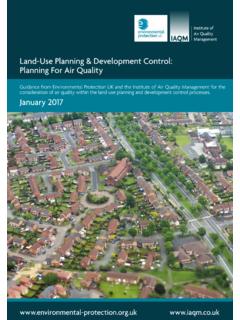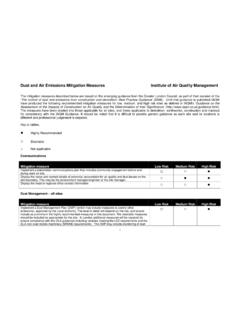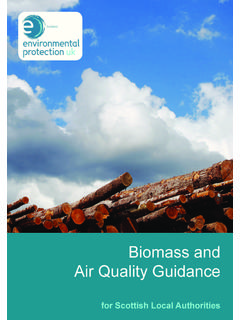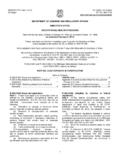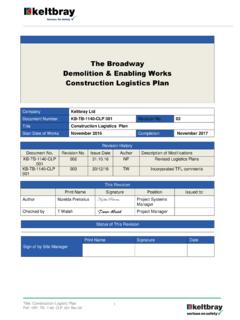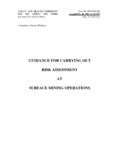Transcription of Example A - IAQM Dust Assessment v2
1 IAQM construction dust Guidance (December 2011). Assessment Example A (v2) [Note: the Example dust risk Assessment below is intended to demonstrate some of the issues which may be considered for a particular (theoretical) development scheme. It is a requirement of the IAQM construction dust Impacts guidance that the assessor presents evidence for dust emission and risk category classification for their scheme. This Example should therefore not be used as a template or as an Example of what would be considered acceptable in relation to any other (actual) scheme.]
2 ] Example A Plan See attached. Description A large residential development scheme (450 units) on greenfield land in the South West of England to be built over 3 phases. It is the intention of the builder to construct phases 1 and 2 in subsequent years and phase 3 some time in the future (yet to be determined). The development lies laterally along a road with existing receptors only at the southern end. Key points / issues: residential development scheme, 450 units: construction materials will be timber frame with brick walls; occupation will be phased ( moving receptors), total developable land area = 18,000m2; Greenfield land ( no demolition); Sandy loam soils, flat topography; The closest existing residences are >30m to the public highway, as are those of new occupiers.
3 1971 - 2000 Rainfall , 121 days of rainfall >1mm (month of Feb mm, days of rainfall >1mm); built over 3 phases (two in consecutive years, one later), duration of earthworks 1 month per phase. Project commencement in February. Earth bunds of 6m required on eastern boundary. receptors only at the southern end: 50m from phase 1, 300m from phase 2, 450m from phase 3; access directly onto main road (one per zone): 120m from phase 1 to receptor, 280m from phase 2 to receptor, 430m from phase 3 to receptor; Existing background PM10 = 18 g/m3; Access is directly onto the road network from each development Phase, with paved haul roads.
4 During the most actives stages of construction , 34 HGV trips will be made per day; and There are no sites of ecological / horticultural interest within 2km. IAQM construction dust Guidance (December 2011). Assessment Example A (v2) Assessment Description of the Site and Surroundings The existing background PM10 is 18 g/m3 and as the scheme is in England this is well below the annual objective for this pollutants. A key consideration in relation to this scheme is the treatment of the phases (or zones ). In this case it is the intention of the developer to allow occupation of the phase 1 as the building progresses in phase 2.
5 The closest receptor locations for each additional phase will then become the occupiers of the previous phase and the Assessment must be completed on this basis. However, if a new occupier of a development phase is fully aware of the subsequent development phases it may be argued by the assessor that the occupiers would be more tolerant of the short term dust implications associated with the Phase 2 build. In this Example , the duration of the build is 1 year per phase hence occupiers of the first phase would be exposed to building works from the second phase for less than 1 year after occupation ( once the phase 1 homes are completed, then sold and occupied).
6 This is not the case for Phase 3 which will be developed some time later (yet to be determined). Summary: It is the judgement of the assessor that, in this case, the dust Assessment should assume 2 zones : Zone 1: Phases 1 and 2 Zone 2: Phase 3. The Assessment has been completed on this basis ( effectively considering 2 distinct developments). Assessment Step 1 - Screen the Requirement for a More Detailed Assessment There are (existing) receptors within 350m of the boundary of the Zone 1 development site and within 100m of the route used by construction vehicles on the public highway.
7 There will be (Zone 1) receptors within 350m of the boundary of the Zone 2 development site and within 100m of the route used by construction vehicles on the public highway. Summary: A detailed Assessment for each Zone is required to determine potential dust impacts. Assessment Step 2 Assess the Risk of dust Effects1 1) Demolition The entire development site (both Zones) is on greenfield land. No demolition is required. There is therefore no requirement to define a dust emission class. Summary: Demolition phase Risk category is Not applicable (for either Zone).
8 1 For each activity, an emission class must first be selected. Once the distance to receptors has been identified, the activity may be placed into one of 4 risk categories . IAQM construction dust Guidance (December 2011). Assessment Example A (v2) 2) Earthworks A key consideration in relation to this scheme is the level of detail available to the assessor. In this case, a GANTT chart has been made available detailing a February project start date for Phase 1 (This would be unusual in reality and there also needs to be an awareness that project schedules may change).
9 Given annual phasing, Phase 2 earthworks will also be completed the following February. The schedule for Phase 3 earthworks is unknown and could therefore be during the summer months. Excavation earth works are required over approximately 18,000m2 (across the 2 Zones) with sandy loam soils presenting a soil type with average / low potential for dust release. The duration of earthworks 1 month per phase, Zone 1 earthworks in June, Zone 2 earthworks unknown. Potentially 8 heavy earth moving vehicles will be active at any one time.
10 Based on the detailed information above, it is the view of the experienced assessor that the emission class during Earthworks should be medium . Existing receptors are 50m from phase 1 working and 300m from phase 2 working. Although existing receptors are 450m from phase 3 workings, phase 2 receptors will be immediately adjacent to phase 3 workings when these are commenced ( within 20m). Table A Receptor Risk Existing receptors Medium Risk during phase 1 of Zone 1 earthworks Existing receptors Low Risk during phase 2 of Zone 1 earthworks New Occupiers (Zone 1) High Risk during Zone 2 earthworks Summary: Earthworks phase Risk category is Medium for Zone 1 and High for Zone 2 3) construction construction activities on-site include the use of concrete batching which will be regulated by the local authority.


